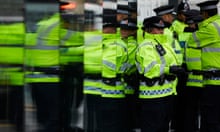Police chiefs have called for a national campaign against online fraud and other cybercrime on the scale of last century’s seatbelt and drink-driving campaigns in the wake of figures showing that one in 10 adults have been victims of such offences in the past year.
Chris Greany, the City of London police’s economic command head, said that with around 1m cases reported to Action Fraud in the last year alone, it was not possible for all cases to be investigated.
On Thursday the Office for National Statistics said there had been more than 5.8m incidents of cybercrime in the past year, far more than previously thought and enough to nearly double the headline crime rate in England and Wales.
The first official estimate of the true scale of online shopping scams, virus attacks, thefts of bank details and other online offences was much higher than an initial ONS estimate in October last year, which put the annual figure at 3.8m, or 40% of all crimes.
Greany said fraud now cost an estimated £193bn a year and with half of all crimes against people in the UK being committed from abroad, it was becoming more challenging for police to tackle.
“Law enforcement agencies are becoming increasingly successful at targeting the most serious offenders; however, the scale of the challenge is such that prevention, and helping businesses and individuals protect themselves, is the only long-term way of combating the escalating threat,” he said. “That includes all industries taking proper steps to protect their customers from becoming victims of fraud.”
Greany endorsed a call for a national fraud and cybercrime campaign on a par with the seatbelt and drink-drive campaigns of the 1980s and 90s to create a more internet-savvy society.
Deputy chief constable Peter Goodman, the National Police Chiefs’ Council lead on cybercrime, said such offending was no longer a curiosity or a new specialism in policing. “The priorities for law enforcement are to make the UK a hostile place for cybercriminals to operate, improve the response to victims and develop capabilities in local forces. Transforming our response to these crimes is a challenge but it is a priority for investment in policing,” he said.
In March the Metropolitan police commissioner, Sir Bernard Hogan-Howe, was criticised for suggesting bank customers who were victims of online fraud should not be refunded by banks if they had failed to protect themselves from cybercrime.
The ONS said one in 10 adults had been victims of cybercrime in the past year. The chance of being a victim was the same regardless of social class or whether someone lived in a deprived or affluent, urban or rural area.
The 5.8m offences were made up of 3.8m fraud offences, including 2.5m incidents of bank and credit card fraud, and 2m computer misuse offences, including 1.4m virus attacks. The remaining 600,000 estimated offences related to unauthorised access to personal information, such as hacking of email, social media or other online accounts.
The latest overall figures, excluding online crime, in the 12 months to March 2015 showed there were an estimated 6.3m offences – 6% fewer than in the previous year.
Police crime figures showed that the murder rate rose by 34 to 571, the highest in five years. This is still far below the peak in 2002-03, when 1,047 homicides were recorded, but the recent rise is one of the more authoritative indicators that Britain is experiencing an increase in violence. The 96 deaths at Hillsborough in 1989 will be added to the official homicide figures and included in the next set of crime figures after the inquests finished in April.
Knife crime offences rose by 10% in the past year and gun crime increased by 4% over the same period.
Incidents of harassment, including new categories of offence such as malicious communications online, social media abuse and revenge porn, had risen 90%, from 82,000 to 156,000.
The police figures also showed a 27% rise in offences against the person and a 21% increase in sexual offences. Those figures include a 22% increase in reported rapes from 29,300 to 35,798. By contrast, the crime survey showed no significant change in the proportion of adults who said they had been a victim of sexual assault in the past year. The ONS said the 21% increase in sexual offences reflected both an improvement in police recording of the offences and a greater willingness of victims to come forward.
But the overall picture of all crime – excluding the 5.8m online offences – according to the crime survey of England and Wales, which is regarded as the best measure of crime trends, showed a 6% fall to 6.3m offences involving adult victims in the 12 months to March 2016.
The long-term trends in “traditional” crimes such as burglary, car thefts and criminal damage showed that the fall in crime since its 1995 peak had slowed down since 2005. The crime survey found there had been no change in the overall level of violent crime compared with the previous year.
The online crime numbers give the first official snapshot of the scale of the threat from online attacks and scams. However, ONS statisticians said it would be “misleading to conclude that this means actual crime levels have doubled, since the survey previously did not cover these offences”.
The first estimate is based on a 9,000-strong sample size from six months of interviews from the crime survey. Only when the ONS has 12 months of data in January will the online crime figures be incorporated into the headline crime rate.
Separate Home Office figures for police officer numbers show they fell by a further 3,126 last year to 124,000 – the lowest level since 2003.Andy Burnham, the shadow home secretary, said: “At long last, we have the true picture of crime in England and Wales and it puts the former home secretary’s record in a new light.
“Our new PM [Theresa May] was fond of saying that crime is falling but, as people can see, crime has moved online and until now the official statistics haven’t shown that. Her complacent claims do not read well alongside these worrying increases in violent crime, sexual crime and homicide.
“The only conclusion that can be drawn is that it is the wrong time to be cutting the police. The PM promised real-terms protection but has failed to deliver it. Now that decision is entirely within her hands, she must honour the promise that she made and protect frontline policing,” he said.
The policing minister, Brandon Lewis, said: “As crime falls, we know that it is also changing. Fraud and cyber-offences are not a new threat and the government has been working to get ahead of the game, committing to spend £1.9bn on cybersecurity and cybercrime over the next five years. We have also established the joint fraud taskforce, bringing together law enforcement and the banking sector, while Action Fraud, the National Fraud Intelligence Bureau and the National Crime Agency are working to improve our response.
“We welcome today’s experimental ONS figures on fraud and cybercrime – offences which we have always known were happening but were previously unable to quantify. Having an accurate national picture will be crucial to inform future action.”











Comments (…)
Sign in or create your Guardian account to join the discussion